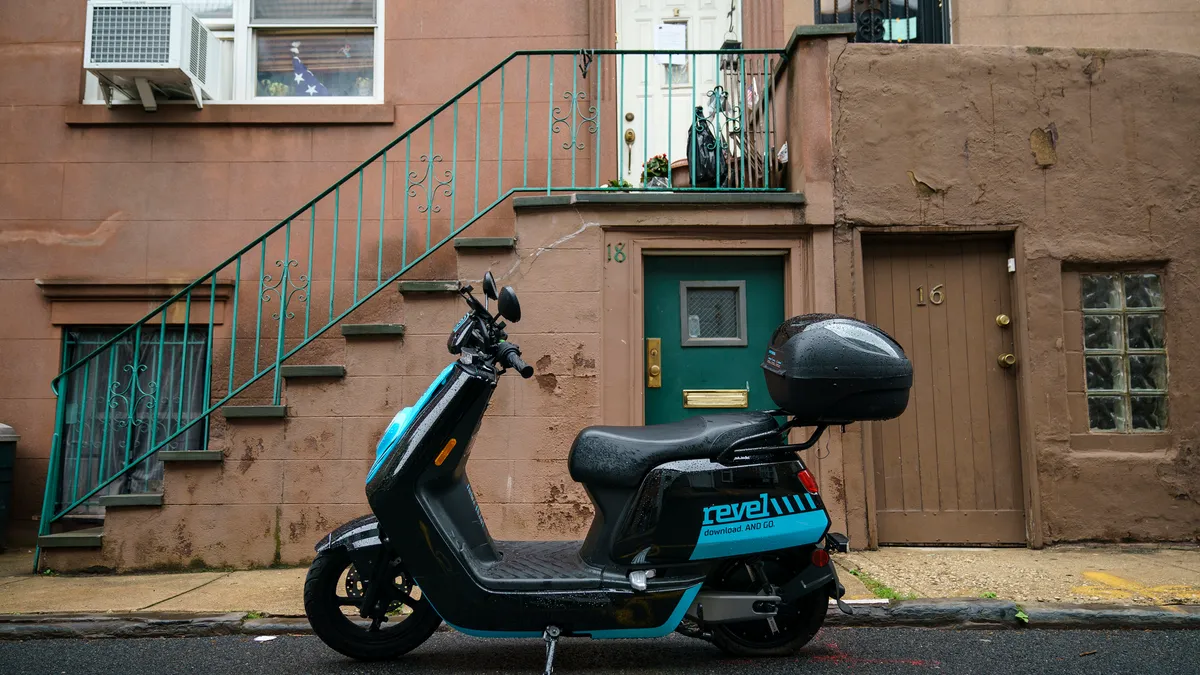Andy Thornley, a senior analyst in the parking and curb management department at the San Francisco Municipal Transportation Agency, says he’s excited by San Francisco’s shared electric moped service, operated by the company Revel. “If you’re leaving behind a large [gasoline-powered] vehicle and getting on an electric moped, you’re hitting multiple policy goals,” Thornley said.
Those goals include reduced emissions, more available public space (mopeds can park between cars on the curb, using otherwise wasted space) and fewer deadly accidents compared to car use (the mopeds are small, and they only reach speeds of 30 mph).
Haley Rubinson, vice president of corporate affairs at Revel, points out other advantages of mopeds as a form of micromobility. Compared with e-scooters, mopeds are known quantities, she says: They’ve been on U.S. streets for more than a century.
In general, states already have regulations for vehicles such as mopeds. That’s why Revel’s moped riders need driver’s licenses and need to wear helmets, whereas age limits, helmets and other requirements for e-scooter users can vary from city to city. Cities can issue permits for moped operations that might encourage their use, such as by giving electric mopeds free parking.
Beyond that, the nature of mopeds allows “relatively seamless integration” in cities, Rubinson said. Mopeds also can cover greater distances in an average trip than scooters, so they might be more suited to replacing cars.
With those advantages, why aren’t shared mopeds more popular in the U.S.? Shared moped services currently only operate in New York City and San Francisco; both are run by Revel. Earlier this month, Revel ended operations in Washington, D.C., which it started in 2019. Lime pulled its mopeds from New York and Washington earlier this year. In June, Pittsburgh’s shared moped company, Scoobi, shuttered. Shared mopeds have also left Austin, Texas, and Miami.
Meanwhile, shared moped use is expanding in other regions of the world, including Europe, Asia and Latin America, according to a report by INVERS, a German mobility tech company. Worldwide, the number of cities with shared mopeds increased from 17 in 2016 to more than 220 this year, the report states, and the number of shared moped service operators grew from 15 to 94 in that period. Taiwan has the most extensive moped-sharing fleet of any country, with roughly 20,000 mopeds on its streets. In contrast, the report estimates North America has 9,500 shared mopeds and moped/bike hybrids combined.
Cost of deployment is one reason shared e-mopeds have failed to gain popularity, Rubinson suggests. Shared e-scooters are cheaper — that’s partly why they could initially flood cities — whereas mopeds are a significant investment for a company, Rubinson said. Not only are mopeds more expensive vehicles, but Revel also pays for insurance for riders, she said.
It's possible the issue with U.S. shared mopeds lies in why cities are drawn to them in the first place. Cities like e-mopeds’ potential to do much of what a car can do, but with lower safety, environmental and traffic impacts. However, research in one city has shown that micromobility use is not replacing car use.
Last month, Pittsburgh released a report that examined its micromobility pilot program, which included Scoobi’s shared e-mopeds. The deployment of the e-mopeds “presented some challenges in operations,” the report states, namely the higher barrier to access. To use the e-mopeds, residents needed a driver’s license, and they had to watch an onboarding video and take a quiz. “This made spontaneous use of the e-mopeds cumbersome for many potential users,” the report states. From July 2021 to May 2022, riders took more than 11,000 trips on the e-mopeds, more than 14,000 miles total, with an average trip distance of 1.29 miles and an average duration of 24 minutes. The report states that the average utilization of the 100-moped fleet was around 0.5 trips per vehicle per day.
While the report did not collect data on how e-moped users would have traveled if they did not have that option, just over a third of survey respondents who used e-scooters said their e-scooter trips replaced private car trips. Otherwise, scooters were largely (43%) replacing public transit and walking.
Shared e-scooters may “generate more emissions precisely because they replace walking and transit trips in corridors where alternative modes of transit are highly accessible,” said Laura Chu Wiens, executive director of the grassroots group Pittsburghers for Public Transit.
With 78% of e-scooter trips being less than 1.5 miles, according to the report — slightly longer than the average e-moped trip — it’s reasonable to assume e-moped users were also using those devices to replace public transit and walking.
What’s different about New York and San Francisco compared with cities like Austin, Pittsburgh, and Miami is that residents may not need a car in the former two cities. Indeed, car ownership in these dense cities may be more trouble than it’s worth. But in Austin, Pittsburgh and Miami, more than 70% of households report owning at least one car. Thornley notes that U.S. culture matters. “Trillions of dollars have been spent to make driving the legitimate choice, and in many cases, the only choice,” he said, lamenting “the essentialization of automobility” as his agency’s biggest challenge.
The biggest reason Revel left Washington, D.C., was because “we’ve expanded our focus to the electric vehicle fast charging space,” Rubinson said, describing how the company is building fast-charging sites to make it easier for people to choose electric cars. “For us,” she said, “that’s where there is a greater need.”




















